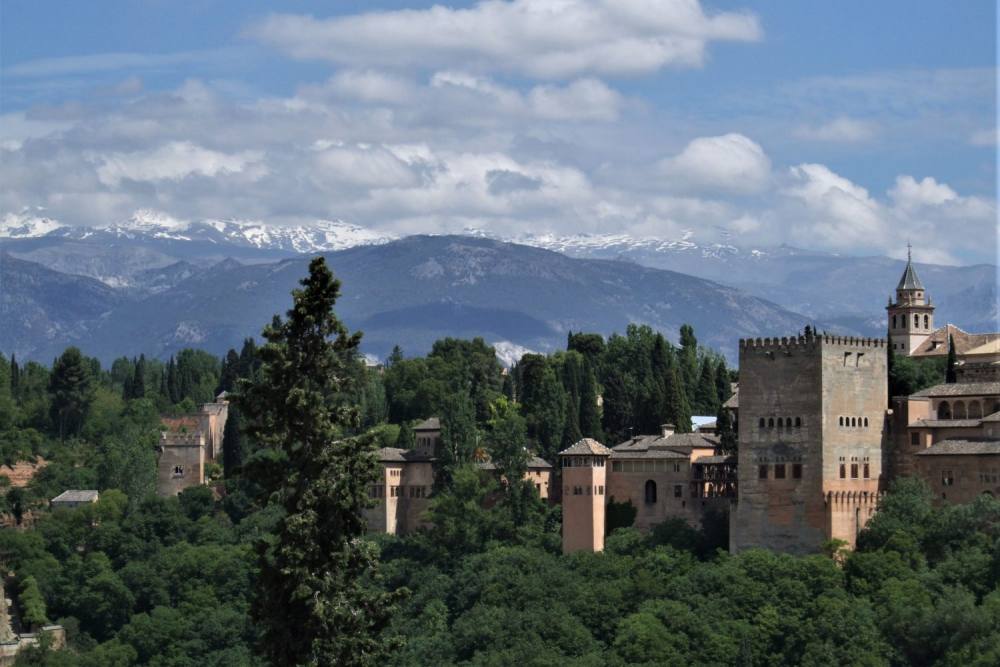- We spent four nights in Granada on our tour of Andalucia. It’s a charming city located at the foot of the Sierra Nevada mountains and the confluence of four rivers. We were attracted here to visit the famous Alhambra and the day we spent exploring this remarkable site was a highlight. There is however much more to the city and its surrounds.
- We took a bus 75 kms to the southeast and spent a lovely day in the whitewashed villages of Las Alpujarras, the region that was awarded to the Moors when they surrendered Granada 1492.
- In the rest of our time we explored the city’s grand Catholic monuments, interspersed with traces of Moorish heritage, and wandered the old Muslin quarter of Albyzin which is draped over a hill facing the Alhambra across the Darro River valley. All in all, Granada was a treat.
- Granada rose to prominence in the 13th C as the base of the Nasrids, the last and longest running Muslim dynasty on the Iberian Peninsula. By 1228 the Almohad Caliphate was in decline in Al-Andalus and Muhammad ibn Yusuf ibn Nasr (Muhammad I of Granada) emerged as an ambitious Muslim leader. Coming from Arjona he took control of several southern cities including Granada (in 1236) and established the Emirate of Granada in 1238.
- With Cordoba (1236) then Seville (1248) falling to the Christians, Granada became the last Muslim stronghold. Muhammad I aligned himself with Ferdinand III of Castille (who took Cordoba and Seville), and this unholy alliance helped to ensure the Nasrid dynasty survived for over 250 years before Granada was surrendered to the Catholic monarchs Ferdinand and Isabella in 1492 to complete the Reconquista.
- It was under the seventh and eighth Nasrid Sultans, Yusuf I (1333-54) and Muhammad V (1354-91), that Granada reached its zenith. They left an amazing legacy of architecture and art most conspicuously expressed in the World Heritage Alhambra building complex and Generalife Gardens.
- The Alhambra receives a huge number of visitors, understandably so, but don’t let this put you off. It’s a very well managed site. We pre-booked a ticket for a specified starting time and walked straight in on the day. As each tour group frogmarched through we just retreated to a corner for several minutes then reoccupied the space when they were gone. For much of the time we were there (several hours) it felt like we had the place to ourselves and a few other like minded souls.
- Our tour of the Alhambra entered through the Puerta de Vino and into Palacio de Carlos V. A wing of the Nasrid building complex was destroyed to make way for this Renaissance palace commissioned by Charles V in 1527, though it was never finished and stood roofless till 1957. It’s an interesting building with a two-tiered, circular coutyard inside. Although it is misplaced amongst the Moorish architecture, it’s far less odious than the Cathedral plonked into the middle of the Great Mosque in Cordoba. The Alhambra Museum is on the ground floor.
- Palacio Nazaries (the Nasrid Palace) is the main attraction and for us it’s one of the most remarkable buildings we’ve seen anywhere in the world.
- First you pass through the Mexuar, an antechamber for receiving visitors, then enter the Patio del Cuarto Dorado (Golden Room) where the emirs would give audiences. Next is the Palacio de Comares built as a residence for Yusuf I. It surrounds the Patio de los Arrayanes (Patio of the Myrtles) which has a beautiful pool. The combination of decorative plaster, wood, and tile decoration on the palace walls surrounding the patio is simply astonishing. The patio opens onto the Salon de Comares with an extraordinary marquetry ceiling representing the seven heavens of Islam.
- It’s thrilling to walk through the Palacio Nazaries and wonder what you’ll see next. Patio de los Lions is certainly a highlight with its beautifully ornamented pavillions.
- We progressed through Sala de los Abencerrajes and Sala de Dos Hermanas, admiring the delicate ornamentation on ceilings and arches. Patio del Lindaraja led us out of the palace and into El Partal gardens with a lovely old portico facing west.
- The Alcazaba was the Alhambra’s citadel and there are fine views of the ramparts and surrounds from Torre de la Vela.
- The Generalife (Architect’s Garden) is a great last stop on a tour of the Alhambra. The beautiful Patio de la Acequia and Jardin de la Sultana have a soothing effect on tired legs and overloaded minds. What a day.
- One day we took a day trip to Las Alpujarras, a collection of valleys on the southern flank of the Sierra Nevada about 75 kms southeast of Granada. Berbers settled here in the 10th C and the area became renowned for irrigated agriculture and silkworm farms, supplying weaving workshops in port city of Almeria. When the Emir Boabdil finally surrendered Granada to the Catholic monarchs Ferdinand and Isobel in 1492, he was awarded Las Alpujarras as part of the settlement. As Catholic promises of religous tolerance were subsequently broken, Las Alpujarras became a hotbed of Muslim insurrection until all of the Moors were finally deported from the region in the late 16th C and replaced with Christian settlers.
- We caught a bus from Granada, up the Poqueira River valley to the village of Capileira. It takes a couple of hours to get there. Capileira is the highest of three villages in the valley. The stone streets, whitewashed buildings, and distinctively shaped chimneys are reminiscent of Berber villages in Morocco’s Atlas Mountains, standing in testament to its Moorish history.
- We spent a lovely day wandering the cobbled streets and along some of the footpaths that radiate into the higher mountains.
![Joey, Dee Dee, Johnny, Tommy lived here]()
Joey, Dee Dee, Johnny, Tommy lived here
- Granada was the last domino to fall in the Catholic reconquest of the Iberian Peninsula. Ferdinand and Isobel had planned to be buried in Toledo, but after capturing Granada in 1492 they commissioned the Capilla Real (Royal Chapel). Their marble funerary monuments lie side by side in the chancel though their bodies are in simple lead coffins in the crypt below. The Capilla Real was not completed until 1521. Isobel died in 1504, Ferdinand in 1516, and they were interred in the Alhambra until the chapel was completed.
- The adjoining Cathedral was commenced in 1521 and not fully completed until the 18th C. The Cathedral and Capilla Real have separate entrances.
- It was pleasant to wander the streets around the Cathedral complex. The Alcaiceria is now an area of tourist shops on the site of the Moorish silk exchange. Nearby Corral del Carbon began life in the 14th C as an inn.
- A little to the north of the city centre is the 16th C Monasterio de San Jeronimo. It has a lovely cloister, excellent stone carvings, and a profusion of brightly painted sculptures. It is the resting place of Gonzalo Fernandez de Cordoba, know as El Gran Capitan (the Great Captain) for his role as Ferdinand and Isobel’s military commander.
- We visited the Archaeological Museum then stopped for lunch before an afternoon wander around Albyzin.
- The old Muslim quarter of Albyzin is also part of Granada’s World Heritage. It’s a delightful area to explore with cobbled streets, whitewashed buildings, and great views across the Darro valley to the Alhambra and the Sierra Nevada beyond. We checked out the Collegiata del Salvador which is a 16th C church built on the site of Albyzin’s main mosque. A patio with Moorish arches survives as a reminder of this history.
- We left Granada well satisfied with our visit to the city and the fascinating region of Andalucia.
![Monasterio de San Jeronimo, cloister]()
Monasterio de San Jeronimo, cloister
![Albyzin, from the Alhambra]()
Albyzin, from the Alhambra

















































